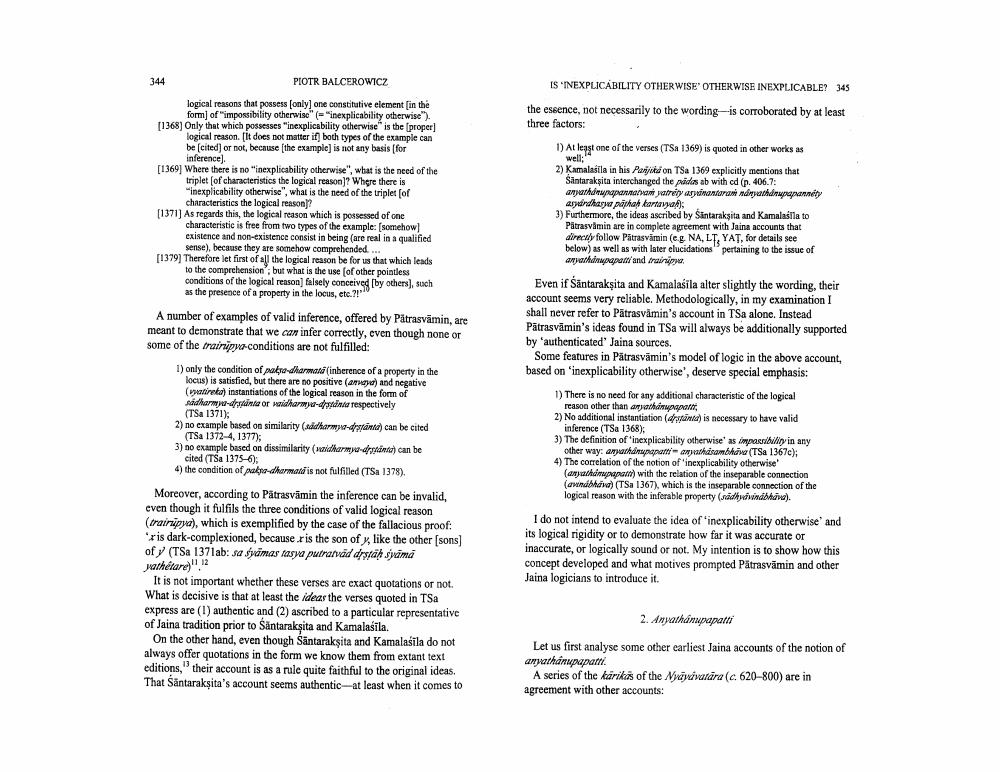Book Title: Is Inexplicability Otherwise Otherwise Inexplicable Author(s): Piotr Balcerowicz Publisher: Piotr Balcerowicz View full book textPage 2
________________ 344 PIOTR BALCEROWICZ logical reasons that possess [only] one constitutive element [in the form] of "impossibility otherwise" (= "inexplicability otherwise"). [1368] Only that which possesses "inexplicability otherwise" is the [proper] logical reason. [It does not matter if] both types of the example can be [cited] or not, because [the example] is not any basis (for inference]. [1369] Where there is no "inexplicability otherwise", what is the need of the triplet (of characteristics the logical reason]? Where there is "inexplicability otherwise", what is the need of the triplet [of characteristics the logical reason]? [1371] As regards this, the logical reason which is possessed of one characteristic is free from two types of the example: [somehow] existence and non-existence consist in being (are real in a qualified sense), because they are somehow comprehended.... [1379] Therefore let first of all the logical reason be for us that which leads to the comprehension; but what is the use [of other pointless conditions of the logical reason] falsely conceived [by others), such as the presence of a property in the locus, etc.?!" A number of examples of valid inference, offered by Pätrasvamin, are meant to demonstrate that we can infer correctly, even though none or some of the trainipya-conditions are not fulfilled: 1) only the condition of paksa-dharmata (inherence of a property in the locus) is satisfied, but there are no positive (anuaya) and negative (yatireka) instantiations of the logical reason in the form of sadharma-distanta or vaidharmya-distanta respectively (TSa 1371); 2) no example based on similarity (sadharma-dranta) can be cited (TSa 1372-4, 1377); 3) no example based on dissimilarity (vaidharma-dränta) can be cited (TSa 1375-6); 4) the condition of paka-dharmata is not fulfilled (TSa 1378). Moreover, according to Pätrasvamin the inference can be invalid, even though it fulfils the three conditions of valid logical reason (trairupya), which is exemplified by the case of the fallacious proof: ris dark-complexioned, because .r is the son of y, like the other [sons] of (TSa 1371ab: sa yamas tasya putratvad dṛṣṭaḥ syämä yathétare) 12 It is not important whether these verses are exact quotations or not. What is decisive is that at least the ideas the verses quoted in TSa express are (1) authentic and (2) ascribed to a particular representative of Jaina tradition prior to Santarakṣita and Kamalasila. On the other hand, even though Säntarakṣita and Kamalasila do not always offer quotations in the form we know them from extant text editions," their account is as a rule quite faithful to the original ideas. That Santarakṣita's account seems authentic-at least when it comes to IS INEXPLICABILITY OTHERWISE OTHERWISE INEXPLICABLE? 345 the essence, not necessarily to the wording is corroborated by at least three factors: 1) At least one of the verses (TSa 1369) is quoted in other works as well; 2) Kamalasila in his Panjikä on TSa 1369 explicitly mentions that Santarakṣita interchanged the padas ab with cd (p. 406.7: anyathanupapannatvam yatréty asyanantara nanyathanupapannéty asyårdhasya pathaḥ kartavyaḥ); 3) Furthermore, the ideas ascribed by Santarakşita and Kamalasila to Pätrasvamin are in complete agreement with Jaina accounts that directly follow Patrasvamin (e.g. NA, LT, YAT, for details see below) as well as with later elucidations" pertaining to the issue of anyathanupapatti and trainpya. Even if Santarakşita and Kamalasila alter slightly the wording, their account seems very reliable. Methodologically, in my examination I shall never refer to Patrasvämin's account in TSa alone. Instead Pātrasvamin's ideas found in TSa will always be additionally supported by 'authenticated' Jaina sources. Some features in Pätrasvamin's model of logic in the above account, based on 'inexplicability otherwise', deserve special emphasis: 1) There is no need for any additional characteristic of the logical reason other than anyathanupapatti 2) No additional instantiation (drama) is necessary to have valid inference (TSa 1368); 3) The definition of 'inexplicability otherwise' as impossibility in any other way: anyathanupapatti anyathasambhava (TSa 1367c); 4) The correlation of the notion of 'inexplicability otherwise' (anyathamupapatti) with the relation of the inseparable connection (avindbhava) (TSa 1367), which is the inseparable connection of the logical reason with the inferable property (nadhydvindbhāva). I do not intend to evaluate the idea of 'inexplicability otherwise' and its logical rigidity or to demonstrate how far it was accurate or inaccurate, or logically sound or not. My intention is to show how this concept developed and what motives prompted Pätrasvämin and other Jaina logicians to introduce it. 2. Anyathamupapatti Let us first analyse some other earliest Jaina accounts of the notion of anyathanupapatti. A series of the karikas of the Nyayavatara (c. 620-800) are in agreement with other accounts:Page Navigation
1 2 3 4 5 6 7 8 9 10 11 12 13 14 15 16 17 18 19 20
